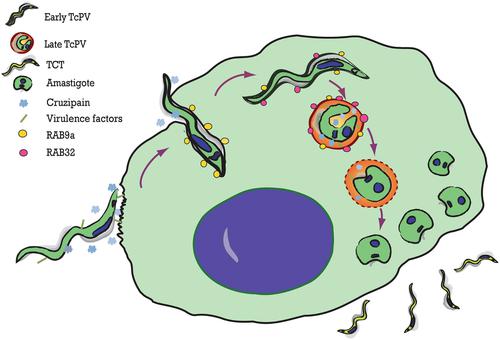当前位置:
X-MOL 学术
›
Mol. Microbiol.
›
论文详情
Our official English website, www.x-mol.net, welcomes your feedback! (Note: you will need to create a separate account there.)
The host Rab9a/Rab32 axis is actively recruited to the Trypanosoma cruzi parasitophorous vacuole and benefits the infection cycle
Molecular Microbiology ( IF 3.6 ) Pub Date : 2024-01-09 , DOI: 10.1111/mmi.15217 Betiana Nebaí Salassa 1, 2 , Juan Agustín Cueto 1, 3 , María Cristina Vanrell 1, 4 , María Belén López 1, 4 , Albert Descoteaux 5, 6 , Carlos Alberto Labriola 7 , Patricia Silvia Romano 1, 4
Molecular Microbiology ( IF 3.6 ) Pub Date : 2024-01-09 , DOI: 10.1111/mmi.15217 Betiana Nebaí Salassa 1, 2 , Juan Agustín Cueto 1, 3 , María Cristina Vanrell 1, 4 , María Belén López 1, 4 , Albert Descoteaux 5, 6 , Carlos Alberto Labriola 7 , Patricia Silvia Romano 1, 4
Affiliation

|
Trypanosoma cruzi, the etiological agent of Chagas disease is a protozoan parasite that infects phagocytic and non-phagocytic mammalian cells. At early stages of infection, trypomastigotes, the infective forms of this parasite, localize in a vesicular compartment called the T. cruzi parasitophorous vacuole until the exit of parasites to the host cell cytoplasm where continue their infective cycle. Rab proteins participate in the membrane traffic's molecular machinery, functioning as central regulators of vesicle recognition and transport. In previous work, we demonstrated that endocytic Rabs are key factors of the T. cruzi infection process in non-phagocytic cells, regulating the formation and the maturation of the vacuole. In this work, we identified and characterized other molecular components of the vesicular transport pathways and their participation in the T. cruzi infection. We found that Rab9a and Rab32, two regulators of the endocytic and autophagic pathways, were actively recruited to the T. cruzi vacuoles and favored the late stages of the infective process. The recruitment was specific and dependent on T. cruzi protein synthesis. Interestingly, Rab32 association depends on the presence of Rab9a in the vacuolar membrane, while the inhibition of the cysteine-protease cruzipain, a T. cruzi virulence factor, significantly decreases both Rab9a and Rab32 association with the vacuole. In summary, this work showed for the first time that specific molecules produced and secreted by the parasite can subvert intracellular components of host cells to benefit the infection. These new data shed light on the complex map of interactions between T. cruzi and the host cell and introduce concepts that can be useful in finding new forms of intervention against this parasite in the future.
中文翻译:

宿主 Rab9a/Rab32 轴被积极招募到克氏锥虫寄生液泡中,有利于感染周期
克氏锥虫(Trypanosoma cruzi)是恰加斯病的病原体,是一种感染吞噬和非吞噬哺乳动物细胞的原生动物寄生虫。在感染的早期阶段,锥鞭毛体(这种寄生虫的感染形式)定位于称为克氏锥虫寄生液泡的囊泡区室中,直到寄生虫退出宿主细胞的细胞质,并在那里继续其感染周期。Rab 蛋白参与膜运输的分子机制,充当囊泡识别和运输的中央调节器。在之前的工作中,我们证明内吞性Rab是非吞噬细胞中克氏锥虫感染过程的关键因素,调节液泡的形成和成熟。在这项工作中,我们鉴定并表征了囊泡运输途径的其他分子成分及其在克氏锥虫感染中的参与。我们发现,内吞和自噬途径的两个调节因子 Rab9a 和 Rab32 被积极招募到克氏锥虫液泡中,并有利于感染过程的后期。招募是特异性的并且依赖于克氏锥虫蛋白质合成。有趣的是,Rab32 的关联取决于液泡膜中 Rab9a 的存在,而半胱氨酸蛋白酶 cruzipain(一种克氏锥虫毒力因子)的抑制会显着降低 Rab9a 和 Rab32 与液泡的关联。总之,这项工作首次表明寄生虫产生和分泌的特定分子可以破坏宿主细胞的细胞内成分以利于感染。这些新数据揭示了克氏锥虫与宿主细胞之间相互作用的复杂图谱,并引入了可用于在未来寻找针对这种寄生虫的新干预形式的概念。
更新日期:2024-01-10
中文翻译:

宿主 Rab9a/Rab32 轴被积极招募到克氏锥虫寄生液泡中,有利于感染周期
克氏锥虫(Trypanosoma cruzi)是恰加斯病的病原体,是一种感染吞噬和非吞噬哺乳动物细胞的原生动物寄生虫。在感染的早期阶段,锥鞭毛体(这种寄生虫的感染形式)定位于称为克氏锥虫寄生液泡的囊泡区室中,直到寄生虫退出宿主细胞的细胞质,并在那里继续其感染周期。Rab 蛋白参与膜运输的分子机制,充当囊泡识别和运输的中央调节器。在之前的工作中,我们证明内吞性Rab是非吞噬细胞中克氏锥虫感染过程的关键因素,调节液泡的形成和成熟。在这项工作中,我们鉴定并表征了囊泡运输途径的其他分子成分及其在克氏锥虫感染中的参与。我们发现,内吞和自噬途径的两个调节因子 Rab9a 和 Rab32 被积极招募到克氏锥虫液泡中,并有利于感染过程的后期。招募是特异性的并且依赖于克氏锥虫蛋白质合成。有趣的是,Rab32 的关联取决于液泡膜中 Rab9a 的存在,而半胱氨酸蛋白酶 cruzipain(一种克氏锥虫毒力因子)的抑制会显着降低 Rab9a 和 Rab32 与液泡的关联。总之,这项工作首次表明寄生虫产生和分泌的特定分子可以破坏宿主细胞的细胞内成分以利于感染。这些新数据揭示了克氏锥虫与宿主细胞之间相互作用的复杂图谱,并引入了可用于在未来寻找针对这种寄生虫的新干预形式的概念。



























 京公网安备 11010802027423号
京公网安备 11010802027423号